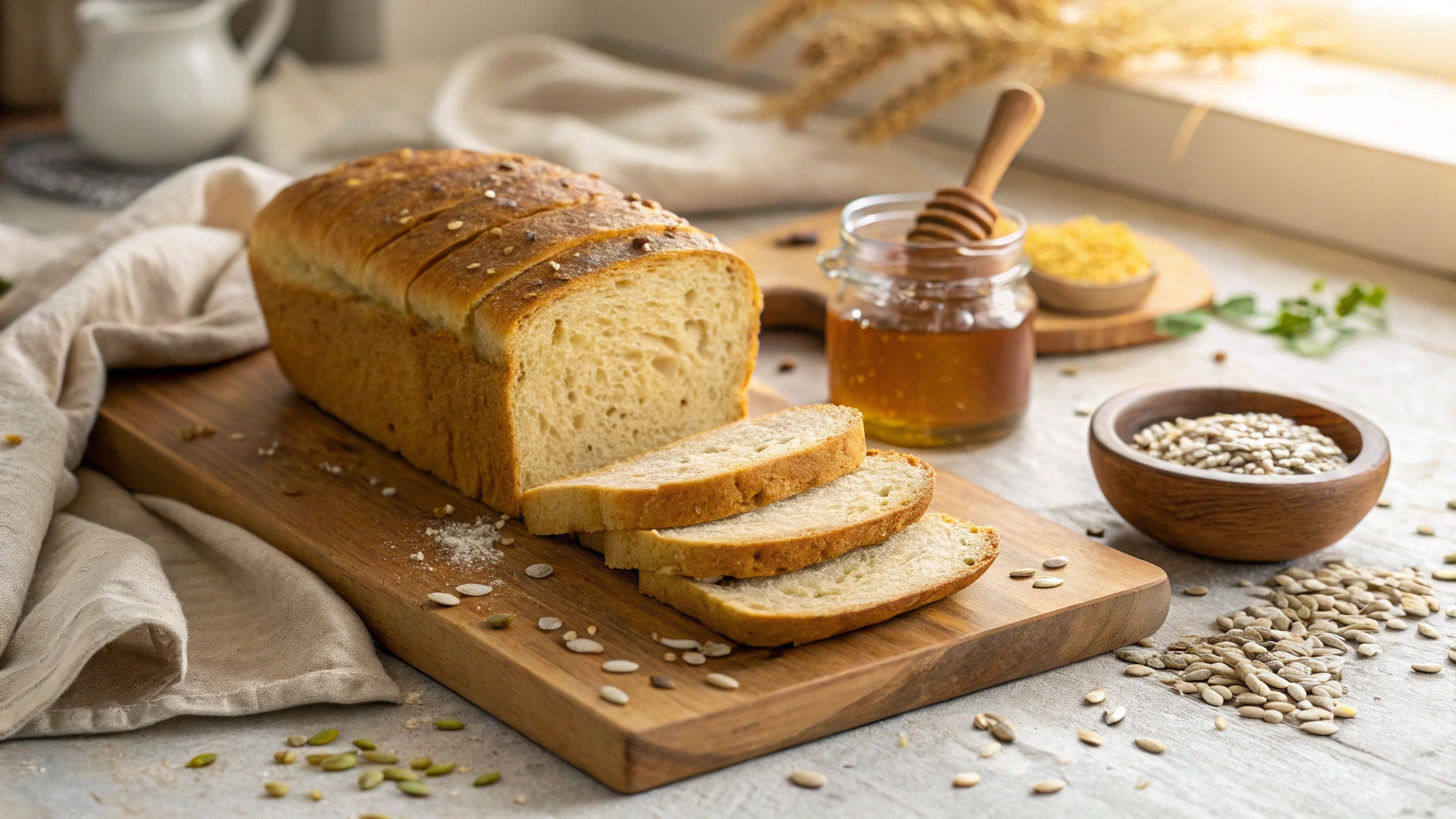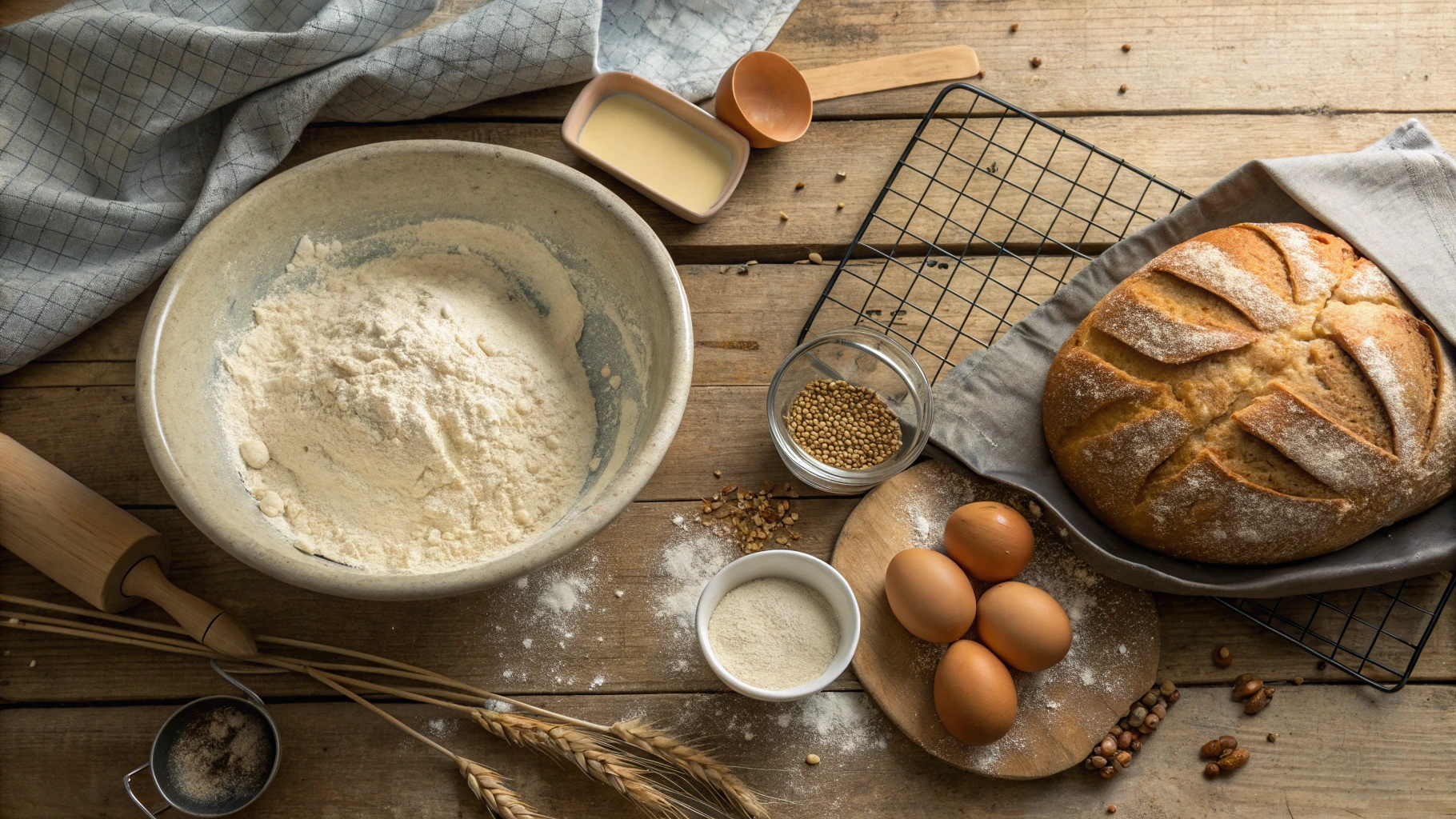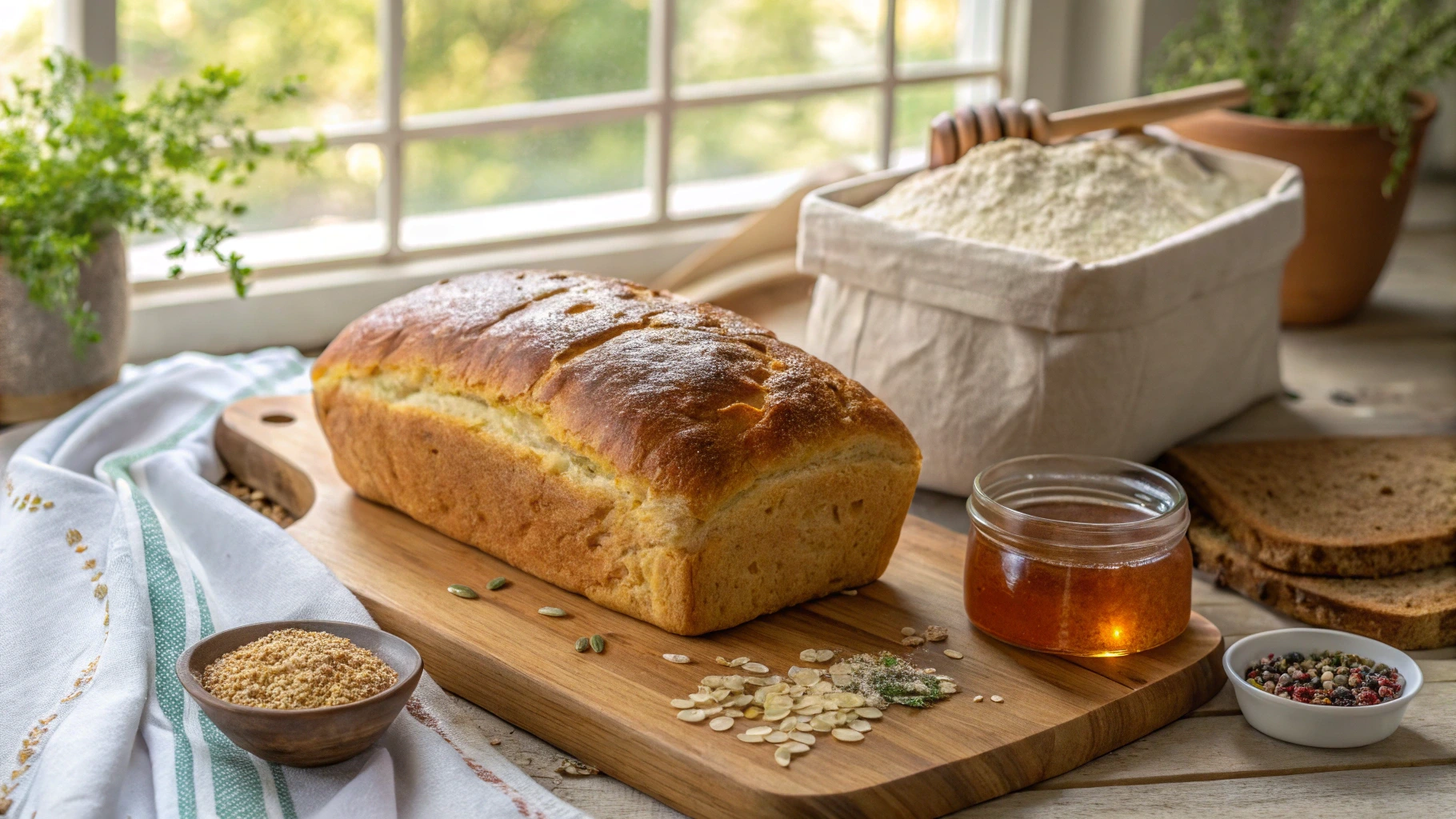Understanding Homemade Bread vs. Store-Bought Bread
Homemade bread and store-bought bread differ significantly in ingredients, preparation methods, and overall health benefits. To understand whether homemade bread is really healthier, it’s crucial to compare these two types.
- Homemade Bread:
- Made with basic ingredients like flour, water, yeast, and salt.
- No added preservatives or artificial chemicals.
- Allows full control over the quality and quantity of ingredients.
- Store-Bought Bread:
- Often contains preservatives to extend shelf life.
- Includes artificial flavors and added sugars.
- Mass production can compromise the nutritional profile.
A key advantage of homemade bread is its lack of additives, which can make it a healthier option. Additionally, the flexibility to choose high-quality flours, seeds, and other wholesome ingredients enhances its appeal. However, store-bought bread is undeniably more convenient and readily available.
In conclusion, the debate over is homemade bread really healthier often hinges on individual preferences for convenience versus health benefits.
Nutritional Profile: Homemade vs. Store-Bought
When comparing the nutritional value of homemade bread and store-bought options, the differences become apparent. While both provide essential carbohydrates, the quality of these nutrients varies.
Homemade Bread
- Higher fiber content when made with whole-grain flours.
- Lower sodium levels, as you control the amount added.
- Can incorporate nutrient-dense ingredients like seeds, nuts, and herbs.
Store-Bought Bread
- Contains added sugars to enhance flavor.
- Often enriched with synthetic vitamins to replace nutrients lost during processing.
- May include unhealthy trans fats in certain varieties.
Studies suggest that consuming bread with fewer additives, like homemade versions, can improve digestion and overall health. While store-bought bread may seem more convenient, its higher levels of processed ingredients often tip the scale in favor of homemade bread.
So, is homemade bread really healthier? Nutritionally, it often is.
Is Homemade Bread Healthier for Weight Management?
For those aiming to maintain a healthy weight, bread consumption can be a double-edged sword. Homemade bread provides several advantages for weight management compared to store-bought varieties.
Benefits of Homemade Bread for Weight Control:
- Lower-calorie options are possible by adjusting the recipe.
- Avoids hidden sugars and fats often found in processed bread.
- High-fiber flours can help with appetite regulation.
Drawbacks of Store-Bought Bread:
- Added sugars and fats increase calorie content.
- Low fiber in many white breads can lead to overeating.
By opting for homemade bread, you can tailor recipes to include low-calorie and high-fiber ingredients. Moreover, understanding portion sizes becomes easier, as the bread is free from misleading labels.
When considering is homemade bread really healthier, weight management is one area where it often excels.
Allergies and Dietary Restrictions
One of the greatest advantages of homemade bread is its adaptability to specific dietary needs. Store-bought bread, on the other hand, often contains allergens or ingredients unsuitable for certain diets.
How Homemade Bread Helps with Allergies:
- Gluten-free options can be crafted with specialized flours.
- Eliminates exposure to preservatives and artificial additives.
- Perfect for tailoring recipes to avoid allergens like nuts or dairy.
Store-Bought Bread and Dietary Concerns:
- Cross-contamination risks are higher.
- Many varieties contain hidden allergens like soy or dairy.
For those with allergies or specific dietary restrictions, homemade bread offers a safer and healthier alternative. It’s another factor supporting the idea that homemade bread is really healthier.
The Cost of Homemade Bread: Is It Worth It?
From a financial perspective, making bread at home can seem more expensive initially. However, the long-term benefits often outweigh the upfront costs.
Cost Breakdown of Homemade Bread:
- Ingredients like flour and yeast are inexpensive when bought in bulk.
- Eliminates the need for frequent trips to buy store-bought bread.
Store-Bought Bread Costs:
- Lower upfront cost, but repeated purchases add up over time.
- Premium brands with fewer additives are significantly more expensive.
Homemade bread also provides added value in terms of quality and customization. Though it requires time and effort, the ability to create nutritious, preservative-free bread often makes it worth the cost.
nvironmental Impact: Homemade vs. Store-Bought Bread
Homemade bread is often a more environmentally friendly option compared to store-bought bread, primarily due to reduced waste and resource usage. Understanding the ecological implications of both can help consumers make more informed decisions that align with their values.
Homemade Bread’s Environmental Benefits
One of the most significant environmental advantages of homemade bread is the minimal packaging waste it generates. Unlike store-bought bread, which is typically wrapped in layers of plastic or combined materials that are difficult to recycle, homemade bread can be stored in reusable containers or cloth bags, reducing overall waste.
Additionally, baking bread at home reduces the reliance on mass production systems, which often involve energy-intensive processes. The carbon footprint of homemade bread is significantly lower because it eliminates transportation emissions associated with delivering store-bought bread from factories to distribution centers and, eventually, to retailers. Moreover, when you bake at home, you can source ingredients locally, further reducing the environmental impact.
Homemade bread also allows for better portion control, helping to reduce food waste. Many store-bought loaves go stale or are discarded because they are purchased in bulk or do not meet taste preferences. By making bread in smaller quantities at home, consumers can minimize such waste.
Store-Bought Bread’s Environmental Costs
Store-bought bread contributes heavily to environmental degradation, starting with its packaging. Most commercially produced bread is wrapped in single-use plastic, which often ends up in landfills or as litter, contributing to the global plastic pollution crisis. Even when these materials are technically recyclable, inadequate recycling systems in many regions mean they frequently go to waste.
Furthermore, the industrial processes involved in large-scale bread production emit significantly higher carbon footprints. From the energy required to power large baking facilities to the emissions generated by transporting ingredients and finished products, the environmental toll of store-bought bread is considerable. These processes also consume more resources, such as water and energy, compared to baking smaller quantities at home.
Another often-overlooked factor is the agricultural practices used to grow the ingredients for mass-produced bread. Large-scale wheat farming often relies on chemical fertilizers and pesticides, which can harm ecosystems and contribute to soil degradation. On the other hand, individuals making homemade bread can choose organic or sustainably sourced flours, further reducing environmental harm.
For environmentally conscious consumers, the decision about is homemade bread really healthier extends beyond personal health benefits to include sustainability. Homemade bread offers clear advantages in terms of reduced waste, lower carbon emissions, and the ability to support local and organic agriculture. While store-bought bread may offer convenience, its environmental costs make homemade bread the more sustainable choice for those looking to reduce their ecological footprint. By choosing homemade bread, consumers contribute to a healthier planet as well as a healthier lifestyle.
Taste and Customization: A Homemade Advantage
One undeniable benefit of homemade bread is the superior taste and ability to customize. Store-bought bread rarely matches the freshness of a homemade loaf.
Homemade Bread Customization Options:
- Add herbs, spices, and seeds for unique flavors.
- Adjust sweetness and salt levels to suit preferences.
Limitations of Store-Bought Bread:
- Mass production leads to uniform flavors.
- Limited variety in ingredient combinations.
Homemade bread allows bakers to explore recipes from different cuisines, adding variety and enjoyment to their meals. This makes homemade bread not only healthier but also more enjoyable.
The Health Benefits of Freshly Baked Bread

Freshly baked bread offers numerous health benefits, particularly when made at home. Unlike store-bought bread, which may sit on shelves for days, homemade bread is consumed shortly after preparation.
Benefits of Freshly Baked Bread:
- Retains more nutrients compared to processed bread.
- Free from preservatives that can harm health.
- Enhances digestion due to the freshness of natural ingredients.
While store-bought bread is convenient, its health benefits diminish over time as preservatives take precedence over freshness. For this reason, many agree that homemade bread is really healthier.
Potential Downsides of Homemade Bread
Despite its benefits, making bread at home has a few challenges. These potential downsides are worth considering:
Challenges of Homemade Bread:
- Time-consuming, especially for beginners.
- Requires specific tools and skills.
- Shorter shelf life compared to store-bought bread.
However, many of these issues can be mitigated with practice and proper planning. The health and customization benefits often outweigh these downsides.
Expert Opinions on Homemade Bread
Experts, including dietitians and bakers, overwhelmingly agree that homemade bread is not only healthier than store-bought options but also more versatile and rewarding. Their insights shed light on why baking bread at home is worth the effort.
Dietitians’ Perspective
Dietitians often emphasize the significant health benefits of homemade bread due to the absence of artificial additives and preservatives. Store-bought bread frequently contains chemicals designed to extend shelf life, but these substances can negatively impact long-term health. Homemade bread allows you to avoid such additives, focusing instead on wholesome, nutrient-rich ingredients. Dietitians also highlight the ability to control sodium levels and eliminate hidden sugars, which are common in many commercial bread options. This level of customization makes homemade bread a better choice for individuals managing conditions like hypertension or diabetes.
Additionally, dietitians often point out that homemade bread can incorporate ingredients like whole grains, seeds, and nuts, which enhance fiber and nutrient content. This is especially beneficial for improving digestion, regulating blood sugar, and supporting overall heart health.
Bakers’ Perspective
From a baker’s standpoint, homemade bread excels in taste, texture, and creativity. The freshness of a homemade loaf is unparalleled, as it lacks the chemical stabilizers often used to maintain the appearance of store-bought bread. Bakers also appreciate the flexibility in recipes, allowing for endless variations in flavor and style. For example, adding herbs, spices, or even vegetables like spinach can elevate the bread into a unique culinary creation.
Professional bakers frequently stress that the process of making bread at home is not only rewarding but also educational. It deepens one’s understanding of ingredients and techniques, fostering a stronger connection to the food you consume. The craftsmanship involved in baking enhances the overall experience, making homemade bread not just a healthier option but also a more enjoyable one.
When considering is homemade bread really healthier, expert opinions strongly support the idea. Dietitians focus on its superior nutritional benefits, while bakers praise its unmatched taste and customizability. Together, these perspectives provide a compelling case for embracing homemade bread as a staple in a healthier, more satisfying diet.ea.
Common Misconceptions About Homemade Bread
Several misconceptions deter people from baking bread at home. Addressing these myths can encourage more people to try it.
- Myth: Homemade bread is too difficult to make.
- Fact: Simple recipes exist for all skill levels.
- Myth: Store-bought bread is just as healthy.
- Fact: Homemade bread offers greater control over ingredients.
Understanding these facts helps reinforce that homemade bread is really healthier.
Getting Started with Homemade Bread

Starting your bread-making journey can be simple with the right tools and guidance.
Essential Tools:
- Mixing bowls, measuring cups, and a good-quality oven.
Beginner-Friendly Recipes:
- Basic white bread.
- Whole-grain bread with seeds for added nutrients.
By starting small and experimenting, you’ll soon discover the joys of homemade bread.
Looking for bread recipes? Check out our easy homemade bread recipe guide for step-by-step instructions.
FAQs About Homemade Bread and Health
What is the Best Flour for Homemade Bread?
The best flour for homemade bread depends on your health goals and flavor preferences. Whole-grain flours like whole wheat, spelt, or rye are excellent choices for their high fiber content, which aids digestion and promotes heart health. For lighter textures, unbleached all-purpose flour or bread flour with a higher protein content works best. Experimenting with combinations of flours, such as adding almond or oat flour, can further enhance the nutritional profile of your bread.
Is Homemade Bread Still Considered Processed?
Homemade bread is minimally processed compared to store-bought options. While technically any bread involves some level of processing (mixing, kneading, and baking), homemade versions lack preservatives, additives, and artificial flavors. The fewer and more natural the ingredients, the less processed it is. This makes homemade bread a healthier alternative for those avoiding highly processed foods.
Is Bread from a Bread Maker Healthier?
Bread from a bread maker can be as healthy as traditional homemade bread, depending on the ingredients you use. Bread makers simplify the process, but you still have control over what goes into the loaf. Opt for whole-grain flours, seeds, and minimal added sugars to maximize health benefits. The machine’s convenience doesn’t compromise the nutritional quality if you use high-quality ingredients.
Can I Eat Homemade Bread Every Day?
Yes, you can eat homemade bread daily, provided it’s made with healthy ingredients and consumed in moderation. Opt for recipes with whole-grain flours, reduced salt, and no added sugars. Pairing it with nutrient-rich toppings like avocado or lean proteins ensures a balanced diet. However, portion control is key, as bread is calorie-dense, even when made at home.
What is the Healthiest Bread You Can Eat?
The healthiest bread you can eat is one made from 100% whole-grain flours, free from preservatives and added sugars. Whole-grain bread provides essential fiber, vitamins, and minerals, supporting heart health and digestion. Adding seeds, like flax or chia, boosts omega-3 fatty acids and antioxidants, making it even more nutritious. Homemade sourdough bread is another great option, as its fermentation process improves gut health and nutrient absorption.
Conclusion: Is Homemade Bread Worth It?
After examining its nutritional benefits, environmental impact, and customization options, it’s clear that homemade bread often surpasses store-bought varieties. The ability to control ingredients and enjoy fresh, nutritious bread makes the extra effort worthwhile.

